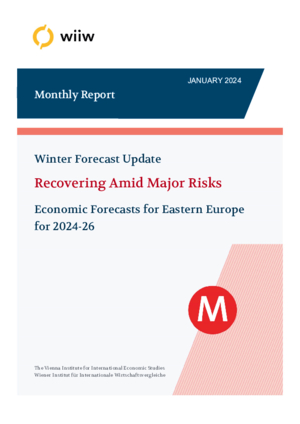Monthly Report No. 1/2024
Vasily Astrov, Alexandra Bykova, Rumen Dobrinsky, Selena Duraković, Meryem Gökten, Richard Grieveson, Doris Hanzl-Weiss, Gabor Hunya, Branimir Jovanović, Niko Korpar, Sebastian Leitner, Isilda Mara, Olga Pindyuk, Sandor Richter, Marko Sošić, Bernd Christoph Ströhm, Maryna Tverdostup and Adam Żurawski
wiiw Monthly Report No. 1, January 2024
50 pages including 5 Tables and 18 Figures
OVERVIEW 2022-2023 AND OUTLOOK 2024-2026
Premium Members only
Summary of key recent macroeconomic data for CESEE, and overview of new wiiw forecasts for 2024-2026 (Excel file)
Winter Forecast Update
Recovering Amid Major Risks
Economic Forecasts for Eastern Europe for 2024-26
As 2024 begins, the global economy is weak and regional and global risks abound, yet the outlook for most of CESEE is actually improving. The region has shown a high degree of resilience to fallout from Russia’s invasion of Ukraine and the highest inflation in decades.
Across most of CESEE, inflation is falling, real wages are rising again and central banks have started to cut policy rates. On top of this, labour markets are strong, external balances are improving and tourism is robust.
Growth in EU-CEE, the Western Balkans and Moldova will strengthen this year. However, Turkey, Ukraine, Russia and Belarus will post slower growth than in 2023, as they continue to struggle with one or more of still-high inflation, monetary tightening and the fallout from the invasion.
From 2025, the recovery should strengthen further, with growth of around 3% or more in EU-CEE, the Western Balkans, Turkey and Moldova. Ukraine’s economy will also continue to grow, but a full recovery is contingent on an end to the war. Growth in Russia will remain below 2%, however, due to sanctions and supply-side constraints, including (most notably) acute labour shortages.
External conditions for CESEE are challenging, to put it mildly. Yet growth in the euro area should strengthen this year, as inflation falls, real incomes recover and global trade gathers momentum.
The risks to the outlook are large and on the downside. They include a delayed German recovery, the potential for tensions in the Middle East to lift oil prices and disrupt global trade, a Trump victory in the next US election, waning Western support for Ukraine, the stalling of the EU enlargement process, and a lack of reforms within CESEE.
Winter 2024 interim forecast update by Statistics Department
1. Global assumptions: Risks abound by Richard Grieveson
2. Regional overview: Recovering amid major risks by Richard Grieveson
3. Austria and CESEE: Recovering growth in the region will help Austria by Doris Hanzl-Weiss
4. Country updates:
- Albania: Riding on the crest of a tourism wave by Isilda Mara
- Belarus: Economy recovers from the shocks, but lacks growth drivers by Rumen Dobrinsky
- Bosnia and Herzegovina: Decent economic growth, increased political instability by Selena Duraković
- Bulgaria: Sluggishness likely to prevail in 2024 by Rumen Dobrinsky
- Croatia: Robust tourism sector and rising wages to underpin growth by Bernd Christoph Ströhm
- Czechia: Waiting for Germany by Richard Grieveson
- Estonia: Recession lingers on by Maryna Tverdostup
- Hungary: Slow recovery after a hard landing by Sándor Richter
- Kazakhstan: Economic growth slows but remains strong by Alexandra Bykova
- Kosovo: Finally, visa-free travel to the Schengen area by Isilda Mara
- Latvia: The upswing needs time by Sebastian Leitner
- Lithuania: Households likely to end stagnation by Sebastian Leitner
- Moldova: Economic recovery at high political risk by Gábor Hunya
- Montenegro: Ambitious plans, cautious optimism by Marko Sošić
- North Macedonia: Emerging from the dark? by Branimir Jovanović
- Poland: Back on the growth track by Adam Żurawski
- Romania: Modest recovery amid fiscal consolidation by Gábor Hunya
- Russia: Military production boom drives economic recovery by Vasily Astrov
- Serbia: Well-worn paths by Branimir Jovanović
- Slovakia: Household spending to drive recovery by Doris Hanzl-Weiss
- Slovenia: Getting back to normal after a year of extreme events by Niko Korpar
- Turkey: Challenges persist despite tighter monetary policy by Meryem Gökten
- Ukraine: Persevering amid dwindling Western support by Olga Pindyuk
Reference to wiiw databases: wiiw Annual Database, wiiw Monthly Database, wiiw FDI Database
Keywords: CESEE, economic forecast, Central and Eastern Europe, Western Balkans, EU, euro area, CIS, war in Ukraine, energy dependence, EU accession, EU Recovery and Resilience Facility, economic growth, labour markets, inflation, stagflation, monetary policy, fiscal policy, GDP, consumer prices, unemployment, current account, fiscal balance, policy rate, exchange rate, political risk, FDI, exports, imports, gas dependence
JEL classification: E20, E21, E22, E23, E24, E31, E32, E5, E62, F21, F31, H60, I18, J20, J30, O47, O52, O57, P24, P27, P33, P52
Countries covered: Albania, Belarus, Bosnia and Herzegovina, Bulgaria, CESEE, CIS, Croatia, Czechia, Estonia, EU-CEE, European Union, Hungary, Kazakhstan, Kosovo, Latvia, Lithuania, Moldova, Montenegro, New EU Member States, North Macedonia, Poland, Romania, Russia, SEE, Serbia, Slovakia, Slovenia, Turkey, Ukraine, Austria, China, Euro Area, Western Balkans, Global economy
Research Areas: Macroeconomic Analysis and Policy, International Trade, Competitiveness and FDI
